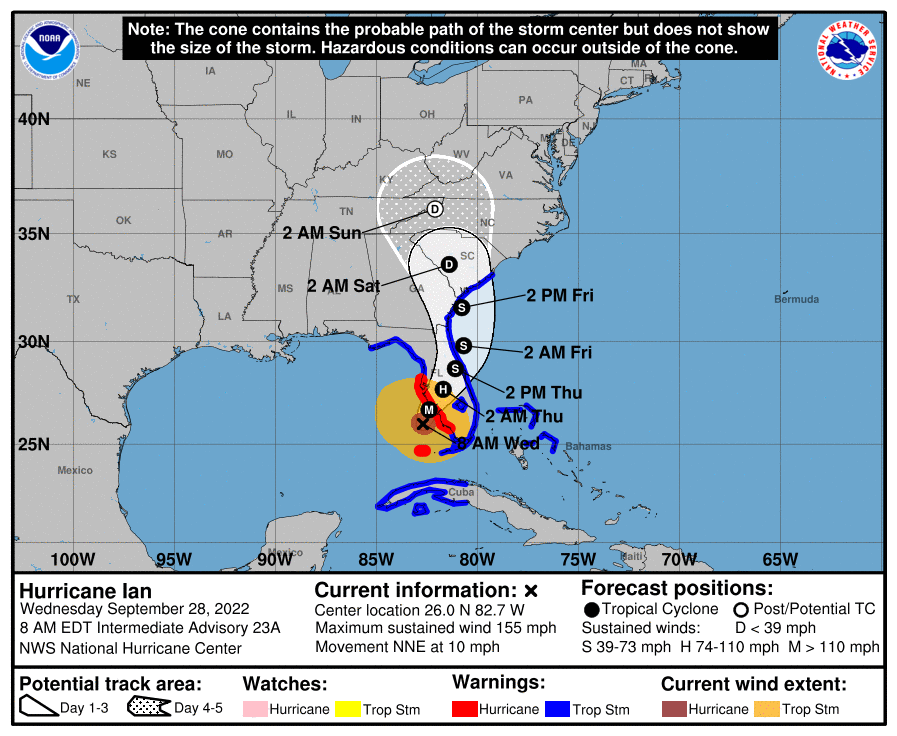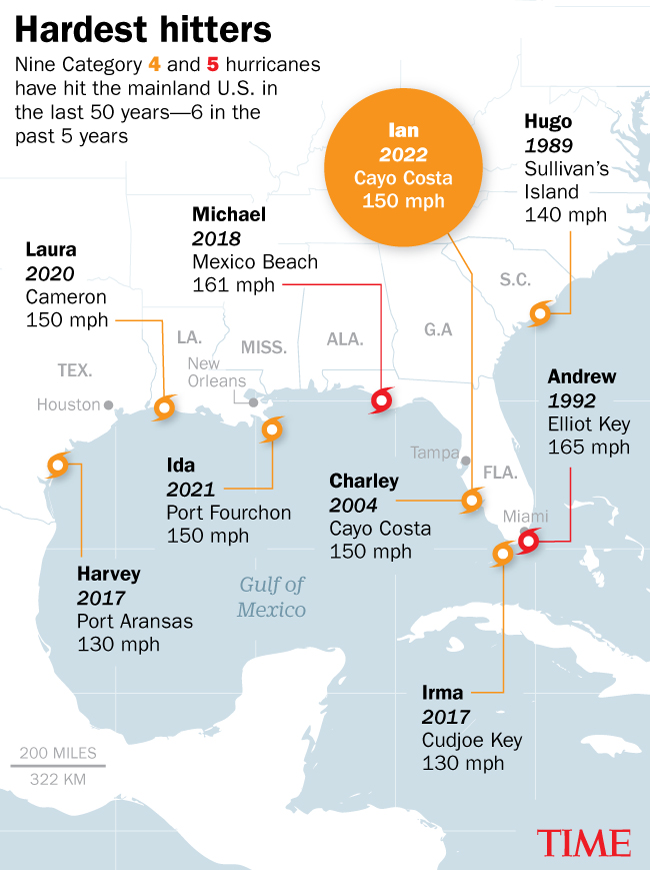Hurricane Ian pummeled Florida’s Southwestern coast Wednesday afternoon before moving toward Orlando in the evening, leaving more than 2.5 million people across Florida without power Thursday and widespread flooding in the areas that were in the category 4 storm’s destructive path. Search and rescues are still underway as dozens of homes remain underwater in Fort Myers, near where the storm, with 150 mph winds, made landfall in Cayo Costa Wednesday.
On Thursday, President Biden said Ian could be the “deadliest hurricane in Florida’s history,” during a FEMA briefing. While the death toll from the storm is unclear, Biden said there could be a “substantial loss of life.”
Although the storm was downgraded from a hurricane to a tropical storm Thursday morning, experts say Ian, which currently has sustained winds of 65 mph and was located 25 miles from north north-east of Cape Canaveral at 11 a.m., could regain strength as it travels across Florida and up the Atlantic coast—threatening Georgia and South Carolina.
“Some slight re-intensification is forecast, and Ian could be near hurricane strength when it approaches the coast of South Carolina on Friday,” the National Hurricane Center said Thursday.
Ian brought torrential rain, storm surges up to 18 feet, flooding that swept away cars, toppled infrastructure, trapped people in their homes and devastated communities across Florida. Officials says it could be days before they’re able to asses the scale of the damage Ian caused.
“You’re looking at a storm that’s changed the character of a significant part of our state,” Fla. Gov. Ron DeSantis said on Thursday morning from an Emergency Operations Center in Tallahassee. “This is going to require, not just the emergency response now, and the days or weeks ahead, I mean this is going to require years of effort, to be able to rebuild, to come back.”
Read More: Yes, Climate Change Is Making Storms Like Hurricane Ian Worse
Desantis added that there were two unconfirmed fatalities in Florida from the storm so far. Emergency officials urge people to seek higher ground and shelter in place until the threat clears completely.
President Biden declared a disaster in Florida Thursday morning, a move that makes millions in emergency recovery aid available, particularly for the counties affected the most, and DeSantis said the state will push for more federal help. In addition to the “thousands of Floridians who need help rebuilding” their homes and businesses, DeSantis said, the storm destroyed hospitals, power lines, roads and bridges that connected islands to the mainland. .
Here’s what you need to know.
Here’s what it’s like in Florida now
Although much of the state lost power and underwent evacuation orders, Southwest Florida, the region where the hurricane made landfall, has been the hardest hit. Coastal storm surges were highest in this area and subsequent flooding and heavy rainfall made the situation worse. On Thursday morning, Ian was still dumping large amounts of rain in the area, and flooding is still a large concern.
On Thursday, emergency responders attempted to work through a backlog of 911 calls in areas where the storm had been impassable like in Cape Coral and Fort Myers where emergency responders had to prioritize “urgent, life threatening situations” first. The Florida Department of Transportation was deployed to clear roads of debris to help disaster responders get around, but DeSantis has asked everyone else to stay off the roads for their own safety.
Gov. DeSantis added during Thursday’s press conference that Ian “is not done creating damage,” and told residents that it’s still a hazardous situation.
Search and rescue efforts are underway in hard hit Lee County where the Sanibel Causeway and Matlacha islands suffered extensive damage. Power is out for 98% of the county as well as much of the water system and parts of the county are under a boil water notice. Lee’s more than 400 traffic signals are also not fully operational and drainage infrastructure in low-lying areas has failed leaving many roads flooded.
Nearby Charlotte County is home to Punta Cana where the water system is currently empty and damaged pipes may take days to repair. The City of Naples in Collier County has asked people not to drive in or to Naples and is under a local state of emergency. DeSoto County, Hendry County and Glades County also all opened temporary shelters.
Power outages and spotty cellular service hit Southwest Florida and in some places, services like sanitation, trash collection and postal service are non functioning for the foreseeable future. More airports have halted operations, including Jacksonville International. Most municipalities in Southwest Florida are asking residents to shelter in place while emergency and public service groups rush to repair essential infrastructure.
Floridians had been preparing for Ian since Monday, especially around the Tampa Bay region where flights were pre-emptively canceled, power was cut in downtown Tampa by the city to mitigate equipment damage from the storm and more than 2.5 million people were given evacuation orders.
What do we know about the Hurricane Ian death toll?
The death toll related to Ian is unclear, but Alongside Biden saying there could be a “substantial loss of life,” Lee County Sheriff Carmine Marceno told Good Morning America on Thursday that he didn’t have a confirmed number of fatalities from the storm, but that he definitely knows “the fatalities are in the hundreds.”
Gov. DeSantis later clarified during a press conference Thursday that Marceno’s statement was an estimate based on the emergency calls that law enforcement received. The governor said that they have not confirmed “hundreds of fatalities.”
Marceno also said Lee County had received thousands of 911 calls over the course of the storm, but that emergency responders “still cannot access many of the people that are in need.”
Similar statements from law enforcement agencies in nearby areas also confirmed that first responders are having a great deal of difficulty accessing flooded neighborhoods and collapsed buildings.
The U.S. Department of Labor put out a statement on Thursday reminding those involved in Hurricane Ian recovery efforts to stay vigilant of hazards that flooding, power loss and storm debris can cause. Such hazards have restricted first responders, particularly throughout Southwest Florida, from helping those trapped or injured.
Officials have said that rescue efforts will continue for the foreseeable future and local authorities have begun making preliminary estimates of death tolls in their communities, including six reported storm-related deaths in Charlotte County, according to county commissioner Chris Constance, and one reported death in Volusia county, according to the Volusia sheriff’s office.
Florida has only experienced a few hurricanes with similar speed and magnitude to Ian, but those proved to be devastating. The most recent example is Hurricane Michael in 2018, which has been linked to 43 deaths.
Where is Ian headed?
A Hurricane Watch remains in effect along the coasts of Northeastern Florida, Georgia and South Carolina as the storm travels northeast across Florida. Tropical-storm-force winds are projected to reach Georgia and South Carolina by late Thursday, then travel further north and have milder effects on North Carolina and Virginia by Friday morning.
Flash flood warnings continue in Florida where much of the state is expected to receive over a foot of rain. Meteorologists predict that Ian could possibly gain hurricane strength again once it reaches the South Carolina coast, but it’s expected to weaken by Friday night and Saturday after moving inland again.

Ian is one of the strongest hurricanes to ever hit the U.S.
Hurricane Ian made landfall as a Category 4 storm with sustained winds of 150 mph. Its maximum sustained winds as it approached Florida were 155 mph. To become a Category 5 hurricane, Ian only needed to reach winds of 157 miles per hour.

Ian is the strongest hurricane to reach landfall in Florida since Hurricane Michael, a Category 5 storm, in 2018. According to Axios, only four recorded hurricanes in the U.S. have made landfall with winds over 155 mph.
Hurricane Michael, which the National Oceanic and Atmospheric Administration (NOAA) labeled as the fourth strongest storm to hit the U.S., caused $25 billion in damages, with the majority of impact occurring in the Gulf Coast of the Florida panhandle.
The five most intense hurricanes to hit the U.S., according to the NOAA, include:
More Must-Reads from TIME
- Cybersecurity Experts Are Sounding the Alarm on DOGE
- Meet the 2025 Women of the Year
- The Harsh Truth About Disability Inclusion
- Why Do More Young Adults Have Cancer?
- Colman Domingo Leads With Radical Love
- How to Get Better at Doing Things Alone
- Michelle Zauner Stares Down the Darkness
Contact us at letters@time.com